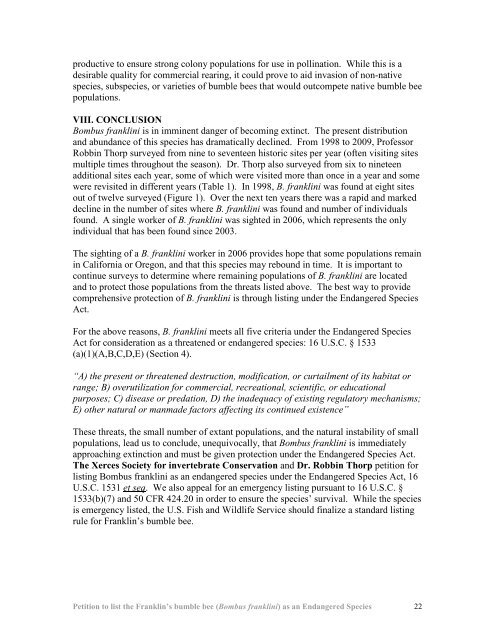Franklin's bumble bee - The Xerces Society
Franklin's bumble bee - The Xerces Society
Franklin's bumble bee - The Xerces Society
You also want an ePaper? Increase the reach of your titles
YUMPU automatically turns print PDFs into web optimized ePapers that Google loves.
productive to ensure strong colony populations for use in pollination. While this is a<br />
desirable quality for commercial rearing, it could prove to aid invasion of non-native<br />
species, subspecies, or varieties of <strong>bumble</strong> <strong>bee</strong>s that would outcompete native <strong>bumble</strong> <strong>bee</strong><br />
populations.<br />
VIII. CONCLUSION<br />
Bombus franklini is in imminent danger of becoming extinct. <strong>The</strong> present distribution<br />
and abundance of this species has dramatically declined. From 1998 to 2009, Professor<br />
Robbin Thorp surveyed from nine to seventeen historic sites per year (often visiting sites<br />
multiple times throughout the season). Dr. Thorp also surveyed from six to nineteen<br />
additional sites each year, some of which were visited more than once in a year and some<br />
were revisited in different years (Table 1). In 1998, B. franklini was found at eight sites<br />
out of twelve surveyed (Figure 1). Over the next ten years there was a rapid and marked<br />
decline in the number of sites where B. franklini was found and number of individuals<br />
found. A single worker of B. franklini was sighted in 2006, which represents the only<br />
individual that has <strong>bee</strong>n found since 2003.<br />
<strong>The</strong> sighting of a B. franklini worker in 2006 provides hope that some populations remain<br />
in California or Oregon, and that this species may rebound in time. It is important to<br />
continue surveys to determine where remaining populations of B. franklini are located<br />
and to protect those populations from the threats listed above. <strong>The</strong> best way to provide<br />
comprehensive protection of B. franklini is through listing under the Endangered Species<br />
Act.<br />
For the above reasons, B. franklini meets all five criteria under the Endangered Species<br />
Act for consideration as a threatened or endangered species: 16 U.S.C. § 1533<br />
(a)(1)(A,B,C,D,E) (Section 4).<br />
“A) the present or threatened destruction, modification, or curtailment of its habitat or<br />
range; B) overutilization for commercial, recreational, scientific, or educational<br />
purposes; C) disease or predation, D) the inadequacy of existing regulatory mechanisms;<br />
E) other natural or manmade factors affecting its continued existence”<br />
<strong>The</strong>se threats, the small number of extant populations, and the natural instability of small<br />
populations, lead us to conclude, unequivocally, that Bombus franklini is immediately<br />
approaching extinction and must be given protection under the Endangered Species Act.<br />
<strong>The</strong> <strong>Xerces</strong> <strong>Society</strong> for invertebrate Conservation and Dr. Robbin Thorp petition for<br />
listing Bombus franklini as an endangered species under the Endangered Species Act, 16<br />
U.S.C. 1531 et seq. We also appeal for an emergency listing pursuant to 16 U.S.C. §<br />
1533(b)(7) and 50 CFR 424.20 in order to ensure the species’ survival. While the species<br />
is emergency listed, the U.S. Fish and Wildlife Service should finalize a standard listing<br />
rule for Franklin’s <strong>bumble</strong> <strong>bee</strong>.<br />
Petition to list the Franklin’s <strong>bumble</strong> <strong>bee</strong> (Bombus franklini) as an Endangered Species 22
















